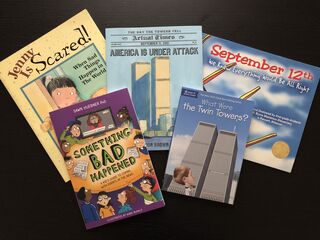Media
Explaining 9/11 and Other Scary Situations to Kids
Sensitive storytelling and key takeaways make a difference.
Updated June 30, 2024 Reviewed by Abigail Fagan
Key points
- An emotional vocabulary is essential to describing trauma and feelings throughout life.
- B-roll aids news depictions but children may see the scary imagery as happening over and over again.
- Children need honest information, age-appropriate data to satisfy their curiosity, until they require more.
Early afternoon on September 11, 2001, I met my second-grade son at the bus stop in Montgomery County, Maryland. School had let out early since students had family working in Washington, D.C. or at the Pentagon, but also, on account of the collective shock.1
“Something really bad happened today,” I began, walking us home. “Remember the tall buildings we visited in New York…” And so the explanations began, as they will this week, marking the 20th anniversary of the terror attacks. A generation had their belief system—all that they knew about safety—questioned that day.
Similar somatic complaints of headaches, no appetite or tummy trouble, sleeplessness or nightmares plus anxiety that affected youth then may put youngsters at emotional peril as we reflect upon the death toll and heroic acts that news footage will provide in an endless stream of B-roll.
Only very young children don’t perceive B-roll as background. For them, it’s foreground, assaulting their senses and possibly creating worry that it keeps on happening. Here’s a guide for various ages when troubling news events occur.

Stories and Play for Young Children (Ages 1-5)
The Academy of Pediatrics calls for virtually no screen time outside of video chats for children younger than two years. Easy, simple: Turn off the television. With youngsters two through five years, ideally getting one hour or less, the same applies.
Parents can set DVRs to capture historic programming and watch privately. If young kids stumble upon footage, witness people upset or bring questions to adults, read age-appropriate stories, such as those published by Magination Press, an American Psychological Association imprint for children. Two books below help children ages four through eight.
Mostly, people do good things. “But sometimes sad things happen and sometimes people do bad things,” writes Carol Shuman in Jenny Is Scared. When that occurs, Cary Pillo, who illustrated this and other books, depicts all the people kids can talk to, even pets to feel better.2
In ABC of Feelings, a beautiful, new picture book, Bonnie Lui portrays feeling words that are essential for caregivers to teach little ones in both scary and ordinary times.3 Beyond words, Margaret Homes shows in A Terrible Thing Happened how children can reveal their emotions through art and play.4

The more a child acts out emotions using dolls, puppets, play dough, sand or art supplies in addition to words, the more the fears subside. Play is the emotional work of childhood. Routine and structure—resuming normal activities—provides youngsters the consistency they need.
Books for Elementary-Ages (Ages 6-12)
In Something Bad Happened: A Kid’s Guide to Coping with Events in the News, Dawn Huebner, Ph.D. provides introductory tips and a handy link to download workbook pages even before the story begins.5,6
Kara McHale’s illustrations are plentiful but do not overpower, showing reactions to and questions about scary news. She depicts discussions, words and tasks via graphics. Simply put: What happened? Why? Will it again? Will it happen to me?
“Big bad things hit people hard,” Huebner explains. “Even when the bad things didn’t happen to us directly, it can still hit us hard.” The jangled nerves and stomach butterflies are signs that our brains go on high alert as we make sense of danger. “Being in high alert when you are safe is a common mistake,” she writes. “When it happens, you need to calm down your brain so you can get back to thinking clearly and feeling better.” Breathing and other exercises follow.
Though an illustrated picture book, America Is Under Attack gets immediately to the details.7 Don Brown mentions Osama Bin Laden on page one, hijacking on the next, writing and illustrating from the perspective of fire chief Joseph Pfiefer who heard the first plane approach.
Onlookers screamed. An inferno shot down the elevator. People were trapped. Firefighters, including Kevin Pfiefer, the chief’s brother, responded. Brown writes about the Pentagon and Shanksville, Pennsylvania. Helicopter pilots communicate above the towers to first responders who rescue some. Others perish, including sadly, the chief’s brother.
What Were the Twin Towers? is a chapter book with 16 pages of photos, available also in eBook.8 Jim O’Connor begins with the clear blue, cloudless day and a tree-lined plaza but steps back to explain the Dutch trading post with its purpose to make money on Manhattan Island and how the Twin Towers project began.
He details this engineering marvel, a city within a city, the view tourists appreciated, and offices locals relied upon. O’Connor describes the first attack in 1993, explaining what is a terrorist and Al Qaeda, how early warnings were missed, and structurally, why the towers fell.

Eleven-year-old Lucas describes his day in the graphic novel I Survived: The Attacks of September 11, 2001 by Lauren Tarshis.9 Lucas took the train to a firehouse that morning to chat with his best football confidante about an important decision. While no happy endings, the book focuses upon heroics when explaining the narrative.
Hope in Messaging
I like that O’Connor’s last chapter focuses on the new World Trade Center, the memorial and museum. It helps children to move forward. Several books focus on first responders and encourage them to talk about troubled feelings.
September 12th: We Knew Everything Would Be All Right focuses on how the sun comes up on another day, birds begin to sing and we come together from the Pledge of Allegiance to flying the red, white and blue.10
“We knew everything would be all right because we had homework,” the Missouri first graders who wrote this book reveal. “2+2 still added up to 4.” That succinctly depicts the consistency kids needed after 9/11.
We didn’t have these handy conversation aids 20 years ago. The world changed that day. Having just moved from Pittsburgh, home to the real Mister Rogers’ Neighborhood, I know I spoke about helpers, something that Rogers’ mother instilled in him as a child.11 Careful explanations offering hope and helpful assurance is what future generations will need also with life’s unsettling events.
Copyright @ 2021 by Loriann Oberlin. All Rights Reserved.
References




